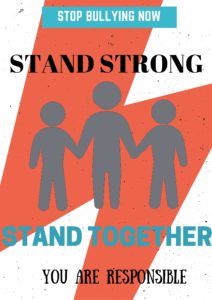Empathy and Friendship Group Project
Cyberbullying is defined formally as the “willful and repeated harm inflicted through the use of computers, cell phones and other electronic devices” (Patchin and Hinduja) With the use of the internet increasing drastically-nearly 3.5 billion people are internet users-individuals all over the world have this tool at their fingertips. This immense connectivity also means that bullying can occur by nearly anyone at any time, especially via social media sites. It is far easier to type unkind words than it is to say them face to face (Patchin and Hinduja). This gives individuals who wouldn’t bully face to face an opportunity to do so quickly and easily. Because of the ease at which cyberbullying can occur it is crucial to find ways to develop empathy in this online environment. Empathy is understanding what someone is feeling. When you see someone in person, they may say they’re fine but you can read their facial clues and see that they are far from being fine. When you talk with someone online, you lack the critical facial clues to see how they are truly reacting to something. With the internet advancing so rapidly, it is easy to sit behind the mask of the screen and make things up or say things about someone. Without being face to face, it is easier for kids (and even adults) to create and circulate posts that could be identified as bullying. Behind a screen, it is easier to lack empathy because you aren’t physically seeing the impact of your words or actions. Teaching children and young adults to foster empathy for those that are different from them can break down biases and blossom into friendships rather than bullying. In Bully, adults used their activism to engage empathetic feelings among other parents and students. If kids were made more aware of the ways bullying can hurt beyond what we can physically see, they can start thinking about bullying differently and realize their personal responsibilities to help stop it. Parents and students sharing their stories are integral to the spread of empathetic awareness. That’s why we chose images and facts on the impact of bullying to represent our individual topics and to engage with the community.
Cyberbullying presents a particularly difficult problem for adolescents because the internet is so readily available and the anonymity that it provides makes stopping this problem very challenging. The fact that it has become so popular speaks to the huge impact that empathy can have on helping to keep bullying to a minimum. The distance the screen puts between the bully and the one being bullied keeps the emotion of how the interaction effects the one being bullied. The film Bully demonstrated how powerful empathy can be when it comes to bullying. One of the boys in the film mentioned how he used to bully kids until he realized how bad it made them feel. In the bonus material, there was a follow up on how the documentary had impacted his life. When kids saw that he was just like any other boy and how the bullying really affected him, they began to talk to him more and treat him better. Bully put people in his shoes and showed them what he was going through on a daily basis. This speaks to how powerful empathy can be when it comes to bullying. Empathy is much harder to push when it comes to cyberbullying, but if programs could be put in place to educate children and foster empathy even this type of bullying could decrease.
The media throws images towards us of what an ideal body looks like. Young children and teens are flooded with ideas of how their body should be and what it means to be man or women. These body standards are affecting children severely, about 1/3 of boys and ½ of girls ages 6-8 feel that they should be thinner (missrepresentation). Due to the fact that childhood obesity is occurring in 18% of the population, a significant portion of these children are at a healthy weight, yet they still feel as if the body they have is not enough. This media portrayal of the ideal body can lead not only to individuals feeling bad about the body they have, but to some it can justify the bullying of others body types. Not only is this type of bullying harmful to an individual’s psychological health, but it can lead to eating disorders, severely harming an individual’s physical health and possibly leading to death (eatingdisorderhope). “Body images are always cultural fabrications, yet we are encouraged to take them for granted as if they were natural” (Cavallaro 20). This quote is so important to take note of, because it is so true. We as members of a society are expected to believe what we see. For girls, we are expected to believe that being dangerously thin with a thigh gap is the only way people will like us. Most specifically, we are taught that if we look a certain way, then people from the opposite sex will love us-and everyone wants to be loved, right? For an eternity women have been told how to look, how to dress, and how to act. We are expected to wear makeup because if we don’t society will shun us. In America, women are expected to shave so that we might appeal to men. Girls have been taught that having long hair is far better than short, otherwise we might be mistaken for a man.
Enter in the body positivity movement, this is an online movement geared towards the acceptance of all body types. This does not merely mean individuals of different sizes, this extends to all genders, ages, and races, and encompasses individuals with physical disabilities as well. This social media presence of this movement is immense and has caused companies to reevaluate the way they market their products. Aerie, a lingerie and apparel store started a campaign: #aeriereal, which is both a social media campaign to celebrate all bodies and a promise not to retouch photos they use in their advertisements. The body positivity movement has lead to a community of empowered individuals and challenges the standard of what a body “should” look like. Through raising awareness and sharing stories of the impact that bullying and societal standards of beauty can have on an individual, this movement has helped foster empathy in both internet users and retail companies.
Our society is diverse and these differences are often looked upon as negatives. Standards are set for what strong, powerful, and normal people should look like and how they should act. If someone doesn’t possess these traits they are treated unfairly. The children that are bullied are targeted because they are different and don’t fit what is considered normal. Empathy and these differences are related because if there were no differences in the world, there would be no need to empathize with others. Our culture has placed a gap between differences and in order for this gap to be closed, people must understand how those that are considered different feel and what they go through on a daily basis. Getting people to empathize would get them to realize the harm that they are causing to the individuals and the society as whole. Friendship is linked to empathy in that a friend is someone you get to know well, you can begin to understand what they are thinking and feeling and you are able to be more empathetic towards them. Building strong friendships helps teach and foster empathy. We can foster friendships across differences by having empathy for the other person. In doing this we realize our differences and how the other feels and behaves, it is understanding differences and generating empathy for an individual that allows friendships to bloom despite differences.
Social media platforms are one of the most common places to find class-based stereotypes and mean-spirited posts aimed at lower-class citizens. Lack of empathy behind the screen and the continued ideas of a social “norm” perpetuate harmful images aimed at those in poverty. Circulations of pages such as “@PoorPeopleProbs” on twitter poke fun at the real life struggles of impoverished people. While it aims to be funny, it points out problems of lower-class citizens and exploits them without any regard to just how hurtful it can be. Maintaining normalcy through the “abnormal” actions or position of others is not the way our society should function.
Bullying via social media generally occurs based on socially constructed ideas of right and wrong. Individuals who do not have the “ideal” body or don’t fit the “ideal” social class or race are bullied for their differences. These two advertisements about being “beach ready” from the 1950’s and today illustrate the different definitions of beauty over time. Showing children and young adults that the concepts of right and wrong, beautiful and ugly are socially constructed and change overtime will help them realize that they don’t have to accept these ideas. Making individuals aware of differences and breaking down social constructs via these social media platforms can shed a light on the impact of cyberbullying and foster empathy in individuals. Developing empathy can allow people to ignore social constructs and develop friendships across differences.



Recent Comments